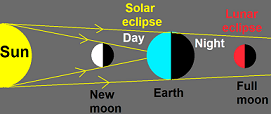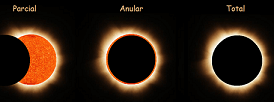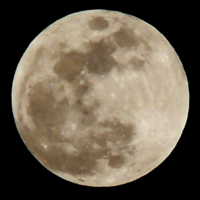Eclipses
The eclipses occur when, from our planet, a celestial body is hidden by another.
Two types of eclipses are distinguished:

By Tomruen [CC BY-SA 4.0 ], from Wikimedia Commons
The eclipses occur when, from our planet, a celestial body is hidden by another.
Two types of eclipses are distinguished:

By Tomruen [CC BY-SA 4.0 ], from Wikimedia Commons
The solar eclipse occurs when the Moon comes between the Sun and the Earth, so the light from the Sun does not reach the Earth. The Sun can no longer be seen because the Moon has interposed.
According to the part of the solar disk that is covered by the lunar disk, it is distinguished:

By Fernando de Gorocica [CC BY-SA 4.0 ], from Wikimedia Commons
The lunar eclipses occur when the Earth passes between the Sun and the Moon. The shadow of the Earth is projected on the Moon, hiding the lunar disk.
For the lunar eclipse to occur, the Sun, the Earth, and the Moon have to be aligned so that the Earth blocks the solar rays, so lunar eclipses only occur in the full Moon phase.
Since the Earth is quite a bit larger than the Moon, it is easy for lunar eclipses to look like total eclipses from many parts of the world.

For a lunar eclipse to occur, there must be a full moon, and for a solar eclipse to occur, there must be a new moon. Since we have a full and new moon every month, why isn't there a lunar eclipse and a solar eclipse every month?
Obra publicada con Licencia Creative Commons Reconocimiento Compartir igual 4.0